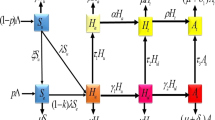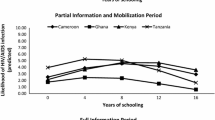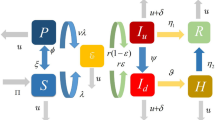Abstract
A nonlinear density-dependent mathematical model is proposed to study the effect of public health education on spread of HIV infection. In this model the host population is divided into seven sub-classes of educated and non-educated susceptibles, HIV infective in asymptomatic and symptomatic phases, and that of AIDS patients. The model exhibits two equilibrium points namely, a disease free and an endemic equilibrium. The model has been studied qualitatively using stability theory of nonlinear differential equations. We have found threshold parameters, the basic reproduction number \(\mathcal {R}_{0}\) for the HIV/AIDS in the absence of public health education and education-including basic reproduction number \(\mathcal {R}_{E}\) for the model with public health education. We have proved that if education-including basic reproduction number is less than one, the disease free equilibrium is locally asymptotically stable otherwise for \(\mathcal {R}_{E}>1\) the infection will be prevalent in the population. By comparing threshold parameters \(\mathcal {R}_{0}\) and \(\mathcal {R}_{E}\), the effect of public health education can be observed. Based upon the presented results of this paper, we can conclude that in a population where public health education is not effective or when the basic reproduction number \(R_0\) is large, HIV/AIDS can not be controlled using public health education alone. Numerical study of the model is also performed to investigate the influence of certain key parameters on the spread of the disease.







Similar content being viewed by others
References
World Health Organization. UNAIDS Report on the global AIDS epidemic. http://unaids.org (2004)
Samanta, G.P.: Permanence and extinction of a nonautonomous HIV/AIDS epidemic model with distributed time delay. Nonlinear Anal. Real 12(2), 1163–1177 (2011)
The HIV–TB reports. World Health Organization. http://www.who.int/en/ (2010)
Srivastava, P.K., Banerjee, M., Chandra, P.: Dynamical model of in-host HIV infection: with drug therapy and multi viral strains. J. Biol. Syst. 20(3), 303–325 (2012)
Yang, Y., Xiao, Y.: Threshold dynamics for an HIV model in periodic environments. J. Math. Anal. Appl. 361(1), 59–68 (2010)
Levy, J.A.: Pathogenesis of human immunodeficiency virus infection. Microbiol. Rev. 57(1), 183–289 (1993)
Stoddart, C.A., Reyes, R.A.: Models of HIV-1 disease: a review of current status. Drug. Discov. Today 3(1), 113–119 (2006)
May, R.M., Anderson, R.M.: Transmission dynamics of HIV infection. Nature 326(12), 137–142 (1987)
Anderson, R.M.: The role of mathematical models in the study of HIV transmission and the epidemiology of AIDS. J. Acq. Immun. Def. Synd. 1(3), 241–256 (1988)
Anderson, R.M., Medly, G.F., May, R.M., Johnson, A.M.: A preliminary study of the transmission dynamics of the human immunodeficiency virus (HIV), the causative agent of AIDS. Math. Med. Biol. 3(4), 229–263 (1986)
Samanta, G.P.: Analysis of a nonautonomous HIV/AIDS epidemic model with distributed time delay. Math. Model. Anal. 15(3), 327–347 (2010)
Samanta, G.P.: Analysis of a nonautonomous HIV/AIDS model. Math. Model. Nat. Phenom. 5(6), 70–95 (2010)
Sharma, S., Samanta, G.P.: Dynamical behaviour of an HIV/AIDS epidemic model. Differ. Equ. Dyn. Syst. 22(4), 369–395 (2014)
Bachar, M., Dorfmayr, A.: HIV treatment models with time delay. C R Biol. 327(11), 983–994 (2004)
Blower, S.: Calculating the consequences: HAART and risky sex. AIDS 15(10), 1309–1310 (2001)
McCluskey, C.: A model of HIV/AIDS with staged progression and amelioration. Math. Biosci. 181(1), 1–16 (2003)
Hethcote, H.W., Van Ark, J.W.: Modelling HIV Transmission and AIDS in the United States. Springer-Verlag, Berlin, vol. 95 (1992)
Hsieh, Y.H., Chen, C.H.: Modelling the social dynamics of a sex industry: its implications for spread of HIV/AIDS. Bull. Math. Biol. 66(1), 143–166 (2004)
Leenheer, P.D., Smith, H.L.: Virus dynamics: a global analysis. SIAM J. Appl. Math. 63(4), 1313–1327 (2003)
Perelson, A.S., Nelson, P.W.: Mathematical analysis of HIV-1 dynamics in vivo. SIAM Rev. 41(1), 3–44 (1999)
Wang, L., Li, M.Y.: Mathematical analysis of the global dynamics of a model for HIV infection of \(CD4^{+} T-cells\). Math. Biosci. 200(1), 44–57 (2006)
Wang, K., Wang, W., Liu, X.: Viral infection model with periodic lytic immune response. Chaos Solitons Fract. 28(1), 90–99 (2006)
Del Valle, S., Evangelista, A.M., Velasco, M.C., Kribs-Zaleta, C.M., Hsu Schmitz, S.F.: Effects of education, vaccination and treatment on HIV transmission in homosexuals with genetic heterogeneity. Math. Biosci. 187(2), 111–133 (2004)
Ostadzad, M.H., Shahmorad, S., Erjaee, G.H.: Dynamical analysis of public health education on HIV/AIDS transmission. Math. Method. Appl. Sci. 38(17), 3601–3614 (2014)
Mukandavire, Z., Chiyaka, C., Garira, W.: Asymptotic properties of an HIV/AIDS model with a time delay. J. Math. Anal. Appl. 330(2), 916–933 (2007)
Van Den Driessche, P., Watmough, J.: Reproduction numbers and sub-threshold endemic equilibria for compartmental models of disease transmission. Math. Biosci. 180(1–2), 29–48 (2002)
Hussaini, N., Winter, A.: Qualitative assessment of the role of public health education program on HIV transmission dynamics. IMA J. Math. Appl. Med. Biol. 28(3), 245–270 (2011)
Cai, L., Li, X., Ghosh, M., Guo, B.: Stability analysis of an HIV/AIDS epidemic model with treatment. J. Comput. Appl. Math. 229(1), 313–323 (2009)
Diekmann, O., Heesterbeek, J.A.P., Metz, J.A.J.: On the definition and the computation of the basic reproduction ratio \({\cal R}_0\) in models for infectious diseases in heterogeneous populations. J. Math. Biol. 28(4), 365–382 (1990)
Perko, L.: Differential Equations and Dynamical Systems. Springer-Verlag, New York (2001)
Hale, J.K., Kocak, H.: Dynamics and Bifurcation. Springer-Verlag, New York (1991)
Mukandavire, Z., Garira, W., Tchuenche, J.M.: Modelling effects of public health educational campaigns on HIV/AIDS transmission dynamics. Appl. Math. Model. 33(4), 2084–2095 (2009)
Acknowledgments
This publication was made possible by NPRP Grant NPRP 6-137-1-026 from the Qatar National Research Fund (a member of Qatar Foundation). The statements made herein are solely the responsibility of the authors.
Author information
Authors and Affiliations
Corresponding author
Rights and permissions
About this article
Cite this article
Ostadzad, M.H., Shahmorad, S. & Erjaee, G.H. Study of Public Health Education Effect on Spread of HIV Infection in a Density-Dependent Transmission Model. Differ Equ Dyn Syst 28, 201–215 (2020). https://doi.org/10.1007/s12591-016-0310-1
Published:
Issue Date:
DOI: https://doi.org/10.1007/s12591-016-0310-1
Keywords
- HIV/AIDS epidemic model
- Density-dependent transmission rate
- Dynamical analysis
- Public health education
- Reproduction number




